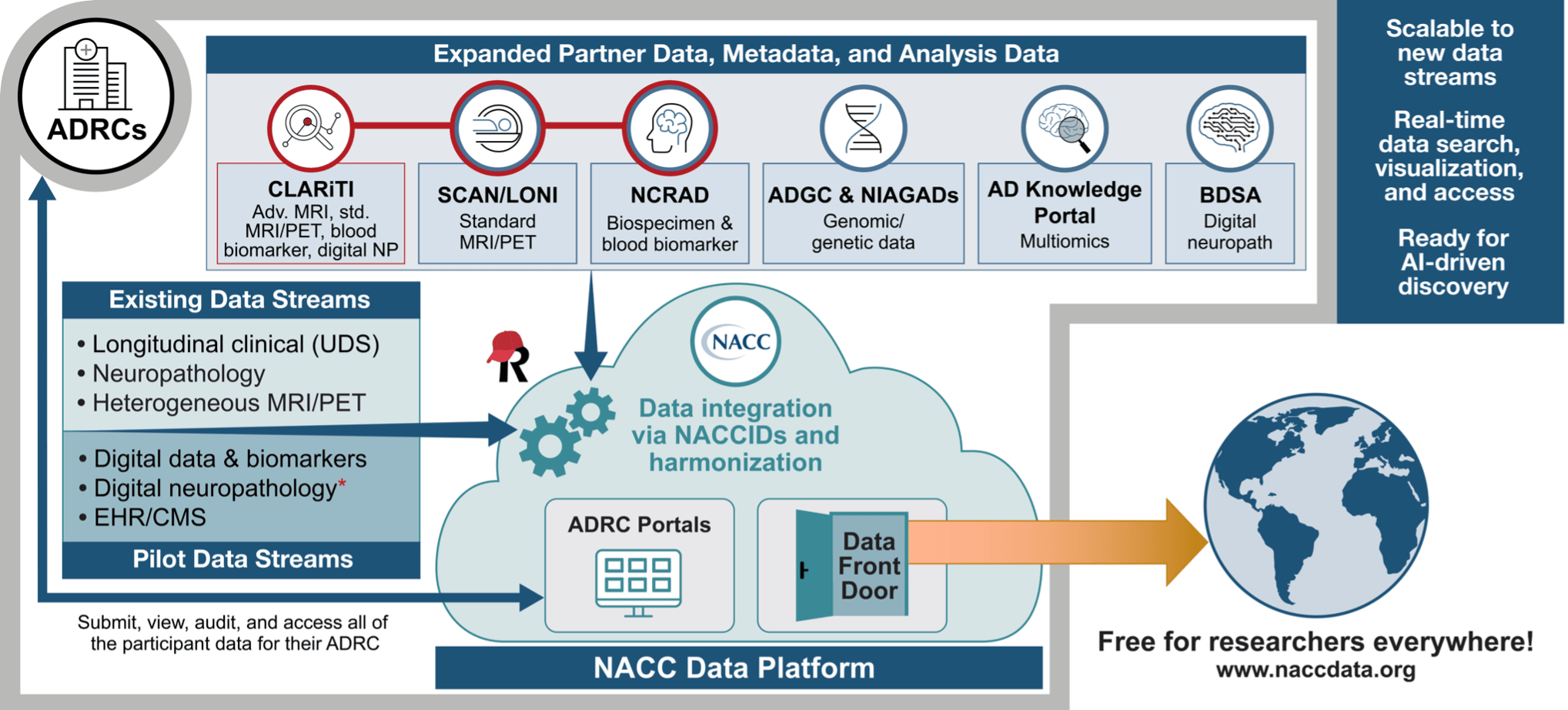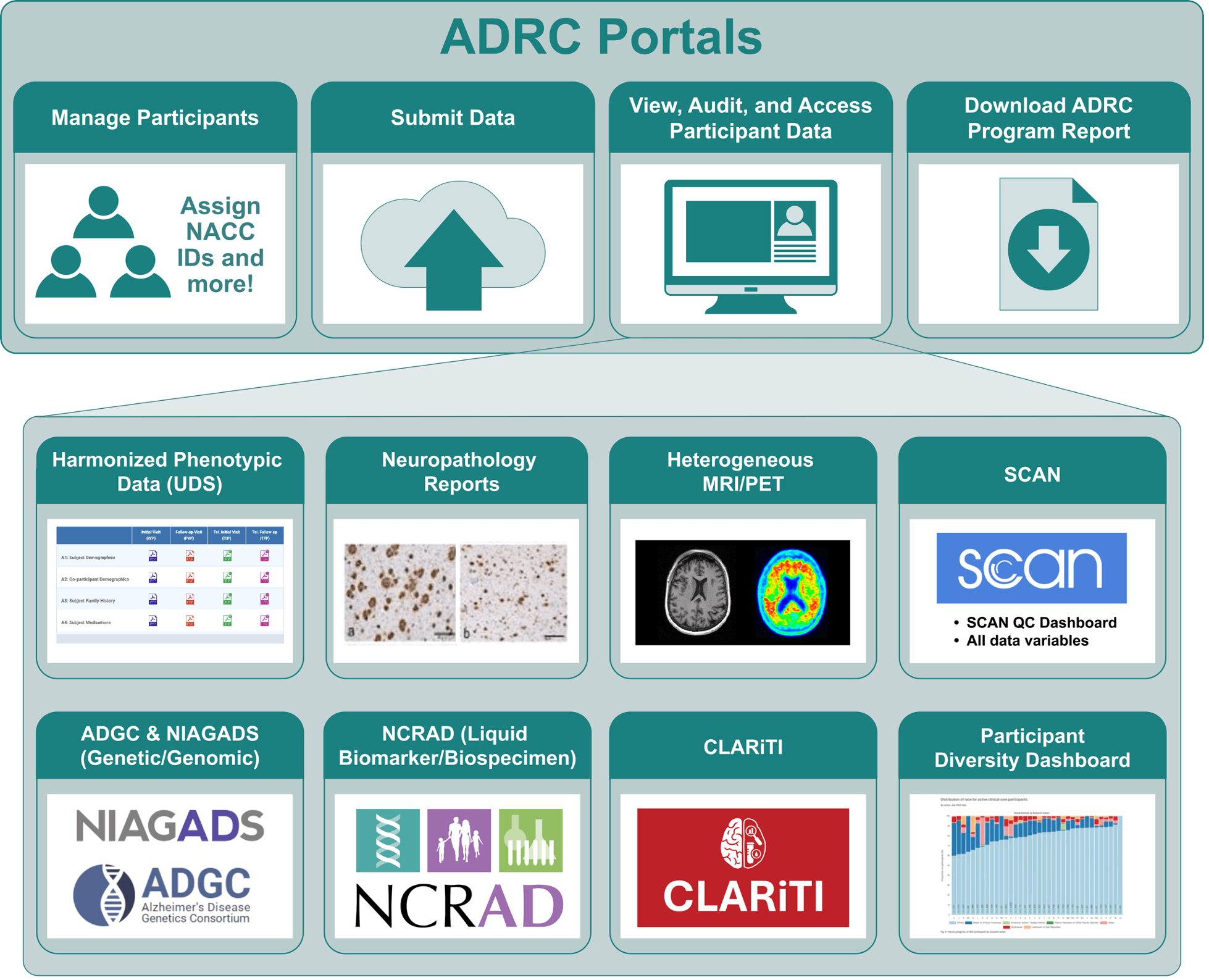NACC's Data Platform
NACC is at the forefront of innovation in multimodal data collection, integration, interoperability, and sharing, driving advances in AD/ADRD discovery and translation. The ongoing bioinformatics infrastructure modernization places NACC at the leading edge of NIA’s new data science strategy and FAIR principles. Key features of this modernization include an electronic data capture system powered by REDCap, a scalable cloud-based NACC Data Platform designed for integrating new data streams and linking data across repositories, and the Data Front Door—an advanced data search, visualization, and access portal that serves as the one-stop-shop for ADRC participant data.

The NACC Data Platform: A Modern Cloud-based Multimodal Data Integration, Harmonization, and Sharing Platform
The National Alzheimer’s Coordinating Center Data Platform (NACC DP) is a cloud-based, multimodal database that integrates existing and new standardized longitudinal data streams from across the National Institute on Aging’s (NIA) Alzheimer’s Disease Research Centers (ADRC) Program, as well as metadata and analysis data from partner organizations and initiatives, with all data streams linked by NACC Identifiers (NACCIDs). The NACC DP will feature a variety of data search and access interfaces including the Data Front Door (DFD) and ADRC Portals.
The NACC DP is designed to make ADRC data as findable, accessible, interoperable, and reusable (FAIR) as possible. It is scalable to new data streams, interoperable with other data repositories, and provides secure sandbox options for collaborative data analysis to support AI-driven discovery. The DFD will enable researchers to tackle new questions in the field and will accelerate Alzheimer’s disease and related dementia (AD/ADRD) discovery. Together, this modernization will also position NACC and the ADRCs at the leading edge of NIA’s new Data Management and Sharing Policy (released Oct 2020) enabling them to amplify their impact and better keep pace with rapid changes in biomedical research and information technology moving forward.
Progress and Goals
The NACC DP modernization is underway and is transforming how NACC:
- Collects data from ADRCs
- Integrates and harmonizes existing and new data streams
- Ensures data quality
- Makes all ADRC data searchable, accessible, and visualizable to ADRCs and AD/ADRD researchers around the world
NACC has already transferred the current ADRC data to the new NACC DP/secure AWS Cloud and has launched the ADRC Portals (the Standardized Centralized Alzheimer’s & Related Dementias Neuroimaging (SCAN) Quality Control (QC) Dashboards and new electronic submission interface are currently available), SCAN Public Dashboard, and streamlined Quick Access File Data Request System.
The system will handle a range of data collection workflows including tabular data such as Electronic Medical Records (EMR), Observational Medical Outcomes Partnership (OMOP), or other clinical data. The Uniform Data Set (UDS) and clinical data will ultimately be collected via a modern electronic interface based in REDCap with integrated and robust data quality processing.
Modern Electronic Data Capture System
NACC is collaborating with the ADRC Electronic Data Capture (EDC) Workgroup to build a modern and scalable EDC System for the ADRC Program.
As of May 2024, the EDC Workgroup is comprised of 97 members from 33 ADRCs who are working together to define requirements, develop REDCap forms, and to provide effective documentation and training materials to the ADRC Program.
Learn more about the EDC workgroup and their impact here
NACC’s modern electronic data capture system will enable electronic data capture and submission via a NACC-hosted REDCap project. Additionally, NACC will continue to host regular batch CSV submissions for the sites for UDSv4. NACC is also providing a third option for data submission via an Application Programming Interface (API), which will provide a method for ADRC systems to automatically connect to and transmit data to NACC.

ADRC Data Portals

The ADRC Portals will provide ADRCs with self-service access to manage participants, submit multimodal participant data, and to view, download, and audit real-time multimodal participant data. The ADRC Portals, housed within the NACC Data Platform, enable each ADRC to submit, view, audit, access, and manage multimodal data for their participants. Amongst other things, these portals will replace inefficient static monthly reports with modern real-time ADRC-specific data portals and on-demand ADRC Program reports, fulfilling an emergent request from ADRCs to have better access to their data submissions. NACC first launched the ADRC Portals in Fall 2023 and continues to add additional Portal components.
Progress and Goals
NACC has launched an ADRC Portal prototype and is actively conducting user testing and building out new components. Each ADRC has their own private ADRC Portal within the NACC DP that is only accessible to designated ADRC representatives. NACC is using User Centered Design to develop dashboards to adapt the ADRC Portal interface to the ADRC program's unique needs.
Registered users can access the ADRC Portals by visiting the NACC Data Platform and logging in with their Institution credentials.
The ADRC Portals will ultimately allow each ADRC to do the following:
- Download GWAS data and accompanying GWAS and Imputation documentation (available now)
- Manage ADRC Participants, including assigning NACCIDs to participants at the time of consent (coming soon)
- Submit multimodal participant data via the NACC DP electronic submission interface – ADRCs can upload batch CSV files, leverage the NACC API, or enter data directly into the NACC REDCap instance (coming soon)
- View, audit, and access data, metadata, and analysis data for different data types, including UDS, neuropathology, mixed protocol MRI/PET, standard MRI/PET (SCAN), fluid biomarker/Biospecimen (NCRAD), genetic/genomic (NIAGADS), digital, and EHR/Claims.
- Check the QC status of their SCAN submissions in real-time and rapidly address errors via the ADRC-specific SCAN QC Dashboards (available now)
- And more!
NACC Data Submission Options

Each ADRC will be able to submit UDS and other data modalities to NACC for their participants via the ADRC Portals, housed within the NACC Data Platform. The new NACC submission interface is designed to be streamlined and to accommodate a variety of data collection approaches at ADRCs, including REDCap, alternative local electronic data capture systems, or PDFs. The submission options that will be available for UDSv4 are outlined below.
- Bulk File Upload - Through the ADRC Portals, ADRCs can upload bulk CSV files that are correctly formatted for UDSv4.
- Submit via API – The API provides ADRCs the option to transfer data programmatically from the Center’s data system to the NACC Data Platform without human intervention. Users do not interact with the API directly. To use the API, Center data system software will need to be built or adapted. Learn how to implement this programmatic option here.
- Direct Data Entry into NACC’s REDCap Project -Through the ADRC Portal, you can access the "Add/Edit Records" page of the appropriate REDCap project on the NACC REDCap instance and enter data directly using the standard REDCap interface with the EDC-developed form instruments.
Data Front Door
One-Stop-Shop for ADRC Data
NACC is making progress on developing the Data Front Door, a one-stop-shop for all ADRC data to be accessed by all audiences interested in Alzheimer’s research datasets. This tool will be freely accessible to researchers around the world via the NACC Data Platform and will allow for data sharing via Quick Access Files, an innovative cohort selection tool, and the SCAN Public Dashboard.
Progress and Goals
NACC has collaborated closely with the National Centralized Repository for Alzheimer’s Disease and Related Dementias (NCRAD), the National Institute on Aging Genetics of Alzheimer’s Disease Data Storage Site (NIAGADS), SCAN, ADRCs, and AD/ADRD researchers to begin to define requirements for the Data Front Door cohort selection tool and is planning to hold focus groups and conduct prototype testing to gather additional input from stakeholders and iteratively improve design features. The cohort selection tool will provide advanced cohort data discovery, analytics, and even machine learning capabilities to data.
Resources available to Researchers now:
- Quick Access File Data Request System: Submit a data request to receive a Quick Access File containing UDS standardized longitudinal data, plus the option to add several other disease-specific modules, imaging data, and biomarker data sets. Data include rich multi-domain neurocognitive clinical and phenotypic data. Approved requests typically receive datasets in 48 hours. Learn more about data options and how to submit a data request here.
- SCAN Public Dashboard: The SCAN Public Dashboard provides researchers with up-to-date information on the number of participants with SCAN-compliant PET and MR images and the total number of images submitted by each ADRC to SCAN.

Get involved with the Data Front Door
NACC, NCRAD, and NIAGADS are eager to partner with AD/ADRD researchers and clinicians from across the ADRC Program and beyond to build the Data Front Door (DFD), a one-stop-shop for all ADRC data. Our goal is to have this platform integrate and connect all ADRC data streams to NACC IDs and serve as an effective search, visualization, and access interface for this data. NCRAD and NIAGADS data will continue to be housed within the NCRAD and NIAGADS databases but biomarker and genetic metadata for all ADRC participants will be searchable through the DFD. Our hope is that harmonizing these data streams and connecting them to NACC IDs will enable researchers to investigate and answer new questions in Alzheimer’s disease.
We welcome you to share your input in two ways:
New NACC ID Process

NACC ID's will be assigned at time of consent
As we move toward collecting and sharing more multimodal data, NACC is launching a new process for assigning NACCIDs. NACCIDs are critical for linking the vast NACC data set with other multimodal data sources. The updated process will advance research by facilitating faster and more flexible data uploads.
NACCIDs are the unique identifiers assigned by NACC for ADRC participants. With the new NACCID process, ADRCs will submit a simple form to NACC to assign NACCIDs to participants at the time of consent. Once assigned, the NACCID will accompany every data type that is submitted for that participant to NACC including UDS, SCAN, Clarity in ADRD Research Through Imaging (CLARiTI), and affiliated study data. The new process will allow for additional NACCID verification, improve flexibility by enabling participant data types to be submitted to the NACC Data Platform in any order, and streamline multimodal data integration. This new process will not affect how ADRCs assign their own site-specific IDs or NIA GUIDs.

